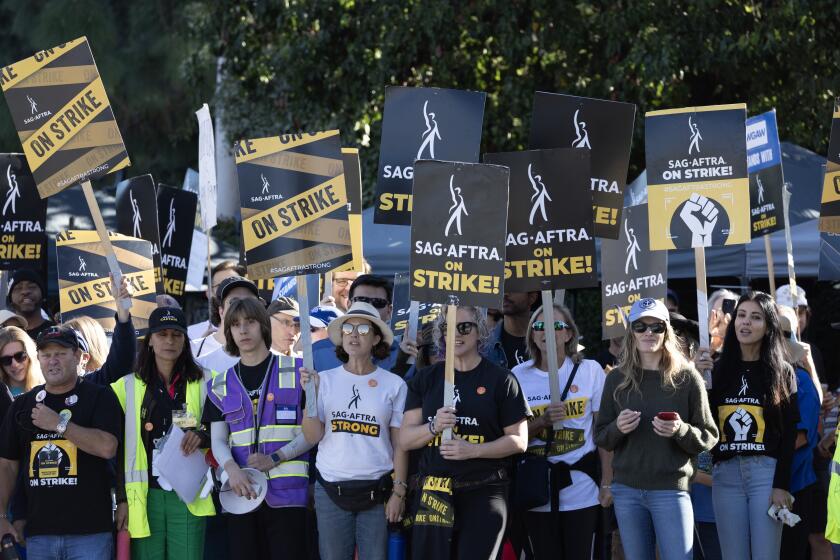Los Angeles loses ground to rivals in film and TV employment but remains the biggest player

- Share via
Los Angeles’ portion of the domestic film and TV economy shrank last year amid devastating industry struggles, but it remains by far the most powerful entertainment player in the United States.
According to the latest Otis College Report on the Creative Economy, released Thursday, the City of Angels posted a 27% share of domestic film and TV employment in 2023 — down 8% from 2022 but still way ahead of its fiercest competitor, New York, which made up 12% of the entertainment workforce.
Other U.S. production hubs lagged far behind Los Angeles. Each claiming 2% of the entertainment pie last year were Atlanta, Dallas, San Francisco, Chicago and Miami; while Nashville, Tenn., Austin, Texas, and Washington, D.C., each hovered at 1% — largely in line with where they stood 10 years ago.
Last year, the entertainment industry was hobbled by six months of overlapping strikes by the Writers Guild of America and Screen Actors Guild-American Federation of Television and Radio Artists.
The Otis College of Art and Design recorded a 17% employment drop in the entertainment industry in Los Angeles during the Hollywood strikes.
Additionally, the Otis report found that workers in Los Angeles County earned 50% of all wages across the domestic film and TV industry last year.
With the exception of New York — long a production stronghold — film and TV activity outside of Los Angeles was spread pretty evenly throughout other parts of the country, leading Otis College to conclude that there is no “New Hollywood” on the horizon.
The new report tracks the pivotal decade from 2013 — when Netflix launched the streaming revolution with the release of “House of Cards” — to early 2024, immediately following the Hollywood writers’ and actors’ strikes.
“Los Angeles is still the apex of the entertainment industry, but the industry itself is undergoing once-in-a-generation changes,” Patrick Adler, principal at Westwood Economics and Planning Associates, said in a statement.
“It is less dependent on film and television studios, more oriented toward online content creation, live events and gaming, and also much more technical and managerial than ever. What it means to work in Hollywood is starkly different today than even 10 years ago.”
Studios and workers alike were eager to restart film and TV production after the Hollywood strikes concluded. What’s taking so long in California?
According to the study, film and TV currently covers about 52% of the entertainment business in Los Angeles County, coming in 12% behind 2013. Employment levels spanning film, TV, sound, broadcasting and print media — all labeled “traditional” entertainment fields by Otis — have similarly fallen roughly 9% from 2013 to 2024.
The waning prominence of film and TV coincides with a drop in production, which is still down 9% from pre-strike levels, according to the report. Film and TV employment in Los Angeles County is 19% lower than it was prior to the work stoppages — leaving thousands of writers, crew members and other entertainment workers in a state of financial and emotional distress.
Otis College previously reported that entertainment employment in the greater Los Angeles area plummeted by 17% during the overlapping writers’ and actors’ strikes.
Previous reporting by The Times illustrates that the production and employment crisis in Los Angeles predates the walkouts and can be largely attributed to an ongoing industry contraction following studios’ overspending during the streaming wars.
2023’s dual strikes by writers and actors created a dry spell for everyone in Hollywood. Crew members are still feeling the aftershocks.
As a result, film, TV, commercial and other production activity in the first quarter of 2024 was about 20% below the five-year average, according to FilmLA, a nonprofit organization that tracks on-location production in the Greater Los Angeles area.
Meanwhile, job growth in “modern” entertainment sectors — identified as software publishing, video gaming, social media, streaming, performing arts, live sports and “independent artists” — rose 53% between 2013 and 2024, Otis College reported.
The fastest-growing corner of the entertainment industry in the county is software publishing (including video games), which has jumped 149% in the last decade. Film, TV and traditional publishing are the only areas that have seen a decline.
Film and TV writers of varying experience levels are struggling to find work after the Hollywood strikes amid an ongoing industry contraction.
The report also determined that the number of college-educated workers in the Los Angeles entertainment industry increased from 46% to 68% between 2000 and 2022.
Creative and management positions accounted for 59% of entertainment jobs in 2013 and had risen to 66% by 2022. Meanwhile, the amount of manual occupations, such as transportation, cleaning, groundskeeping and construction, had declined.
Additionally, the entertainment workforce over the last decade has become more racially diverse. The share of white workers in creative fields decreased between 2013 and 2022, while employment for all other racial groups grew, the report indicates.
“My hope is that the trends identified in this study and our ongoing Otis College Report on the Creative Economy give industry leaders and policymakers insight into the needs of an evolving workforce,” Charles Hirschhorn, president of Otis College, said in a statement, “one that requires more training, investment and education than ever before.”
More to Read
Inside the business of entertainment
The Wide Shot brings you news, analysis and insights on everything from streaming wars to production — and what it all means for the future.
You may occasionally receive promotional content from the Los Angeles Times.















